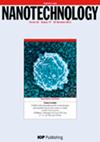Enhancement of photovoltaic parameters of thermally stable graphene/LaVO3 semitransparent solar cell by employing interfacial graphene quantum dots.
IF 2.8
4区 材料科学
Q3 MATERIALS SCIENCE, MULTIDISCIPLINARY
引用次数: 0
Abstract
Semitransparent solar cells are attracting attention not only for their visual effects but also for their ability to effectively utilize solar energy. Here, we demonstrate a translucent solar cell composed of bis(trifluoromethane sulfonyl)-amide (TFSA)-doped graphene (Gr), graphene quantum dots (GQDs), and LaVO3. By introducing a GQDs intermediate layer at the TFSA-Gr/LaVO3 interface, we can improve efficiency by preventing carrier recombination and promoting charge collection/separation in the device. As a result, the efficiency of the GQDs-based solar cell was 4.35%, which was higher than the 3.52% of the device without GQDs. Furthermore, the average visible transmittance of the device is 28%, making it suitable for translucent solar cells. The Al reflective mirror-based system improved the power conversion efficiency (PCE) by approximately 7% compared to a device without a mirror. Additionally, the thermal stability of the device remains at 90% even after 2000 h under an environment with a temperature of 60°C and 40% relative humidity. These results suggest that TFSA-Gr/GQDs/LaVO3-based cells have a high potential for practical use as a next-generation translucent solar energy power source.利用界面石墨烯量子点提高热稳定石墨烯/LaVO3 半透明太阳能电池的光电参数。
半透明太阳能电池不仅因其视觉效果,还因其有效利用太阳能的能力而备受关注。在这里,我们展示了一种由双(三氟甲烷磺酰)酰胺(TFSA)掺杂石墨烯(Gr)、石墨烯量子点(GQDs)和 LaVO3 组成的半透明太阳能电池。通过在 TFSA-Gr/LaVO3 界面引入 GQDs 中间层,我们可以防止载流子重组并促进器件中的电荷收集/分离,从而提高效率。因此,基于 GQDs 的太阳能电池的效率为 4.35%,高于不含 GQDs 的设备的 3.52%。此外,该装置的平均可见光透射率为 28%,因此适用于半透明太阳能电池。与不带反射镜的装置相比,基于铝反射镜的系统将功率转换效率(PCE)提高了约 7%。此外,在温度为 60°C 和相对湿度为 40% 的环境下,即使经过 2000 小时,该装置的热稳定性仍保持在 90%。这些结果表明,基于 TFSA-Gr/GQDs/LaVO3 的电池作为下一代半透明太阳能电源具有很大的实用潜力。
本文章由计算机程序翻译,如有差异,请以英文原文为准。
求助全文
约1分钟内获得全文
求助全文
来源期刊

Nanotechnology
工程技术-材料科学:综合
CiteScore
7.10
自引率
5.70%
发文量
820
审稿时长
2.5 months
期刊介绍:
The journal aims to publish papers at the forefront of nanoscale science and technology and especially those of an interdisciplinary nature. Here, nanotechnology is taken to include the ability to individually address, control, and modify structures, materials and devices with nanometre precision, and the synthesis of such structures into systems of micro- and macroscopic dimensions such as MEMS based devices. It encompasses the understanding of the fundamental physics, chemistry, biology and technology of nanometre-scale objects and how such objects can be used in the areas of computation, sensors, nanostructured materials and nano-biotechnology.
 求助内容:
求助内容: 应助结果提醒方式:
应助结果提醒方式:


